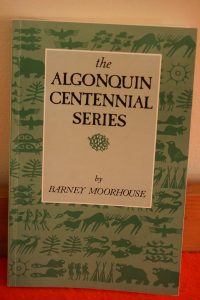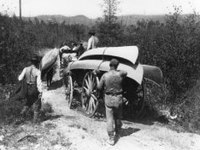FISHING IN ALGONQUIN PARK
In 1892, one year before the birth of Algonquin Park, the Province of Ontario initiated a creel limit that would continue until 1971 when fishing licences for men were discontinued because the government maintained that it was too costly to administer. Women had been exempted from purchasing a fishing licence in 1969. How times change.
Of course the popularity of fishing for food or fun predates the Park. Countless black and white photos of the Hayes Party populate the A.P. archival photo library. These fishermen from Buffalo, N.Y., returned with their Rama Indian guides annually to fish the ponds, lakes and streams of the Park. Keep in mind the effort required to carry the cumbersome camera equipment; especially when compared to to-day’s cell phone.
Under the auspices of G.W. Bartlett a variety of non-native fish species were introduced to the Park. In 1909/10 Atlantic salmon were introduced to Source Lake and perhaps Cache Lake. However, only the small mouth bass, sometimes referred to as black bass, has continued to thrive in Cache, White, Source, and other corridor lakes. While trolling for lake trout fishermen often tie into some heavyweight bass on Opeongo.
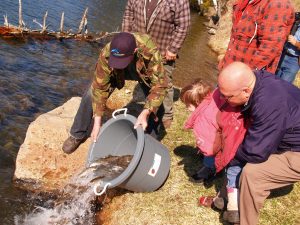
During the WW1 meat shortage Jack Whitton, of Whitney, was given a commercial fishing licence to net white fish and lake trout in Opeongo – probably the only time such a fishing venture was ever permitted within the Park boundaries.
According to one authority 20- 25% of the world’s lake trout are found in Ontario and A.P. has to be considered an important lake trout fishery for yearly numerous fishermen make the pilgrimage there in spite of a creel limit of two fish per person.
In 1955 ice fishing was discontinued as the lakes were considered to be too vulnerable. On some smaller lakes fishermen could devastate fish populations by collectively catching more fish in one day than in an entire season of open water angling.
The lake trout (Salvelinus Namaycush) is native to the glacial lakes of North America. Conditions within the Park can no longer be described as pristine for industrial pollutants globally have taken to the airwaves and come down with the rain. One example is acid rain. That said, A.P. still remains relatively pollutant free and a significant environment for lake trout that mature in 6-8 years and can live a long time. However, they are subject to a low replacement rate. The Park is relatively free of habitat damage that continues to threaten the remainder of the province where development, nutrient pollutants and ever encroaching mankind continue to change more suitable cottage country lakes into mini city environments with the added impact that many lakes, perhaps 5% or more, are losing their natural ability to reproduce lake trout. Proximity to mankind has not proven to be beneficial to lake trout.
Since their introduction motors have been controversial. The Smoke Lake Leaseholders’ Association wanted trolling from boats propelled by mechanical power prohibited. The Ass’n asserted that when people paddled to troll they would stop fishing sooner whereas a motor allowed them to fish until they had achieved their limit. Regulation changes in 1992 reduced motor sizes to 20 h.p. and prohibited ‘fun craft’ such as seas-doos. Previously, in 1955/56, Lands & Forests prohibited planes from landing in the Park due to concern for over fishing.
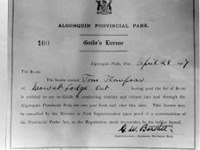
One can’t discuss the impact of fishing in the Park’s development without mentioning Tom Thomson. “Too much has been made of Thomson being a fishing guide. He did guide – some,” a personal acquaintance once explained. No doubt the artist loved to fish. “Tom Thomson had the wilderness in his blood – he loved to go north to fish and to sketch.”
Gordon Wattie, son of a Park Ranger and friend to Thomson, said the artist would visit his father’s cabin. “He used to paint on pieces of slab wood and then use them for kindling. We’d watch the cloud of smoke escape from the chimney and laugh at the colours. Thomson didn’t think his work was any good. One critic described his work as moods smudged into panels.”
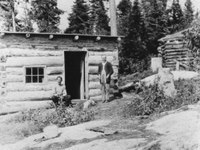
Thomson’s love of the outdoors, fishing, sketching and painting both stimulated and encouraged others, many of whom he introduced to the Park. His death inspired the creation of the Group of Seven whose work is presently widely acclaimed although at one time it was not well received and somewhat controversial. By association one does not think of the Park without seeing the art of A.Y. Jackson, MacDonald, Lismer, Varley, and Lawren Harris, all artists that Thomson encouraged to visit the Park and surrounding territories such as Lake St. Peter. I last saw A.Y. Jackson at the McMichael Collection when he was rather aged.
If the reader has enjoyed these articles of Algonquin Park you may wish to check out my book “the Algonquin Centennial Series” inspired by the impending celebration of the Park’s 100th anniversary. This book is a compilation of popular columns published in The Bancroft Times resulting from interviews with people whose roots date back to a pre-park era in addition to historical and archival research. Books are for sale at Ashlie’s Books (Bancroft), The Old Hastings Mercantile (Ormsby) and at the Algonquin Park book store. B.M.
